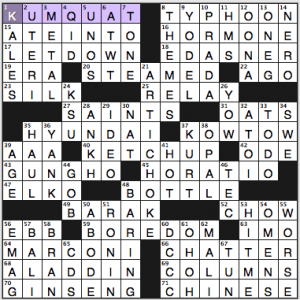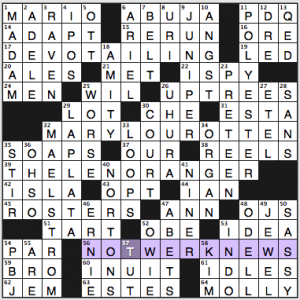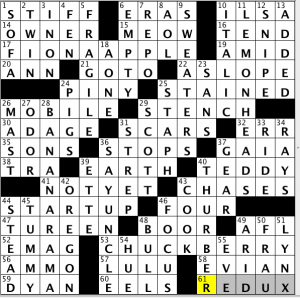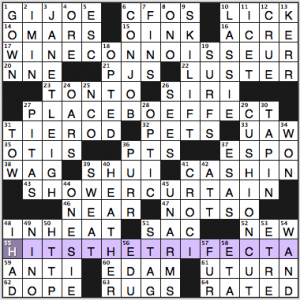NYT 3:10
Jonesin' 3:27
LAT 2:46
CS 5:15 (Dave)
Xword Nation untimed (Janie)
Zhouqin Burnikel’s New York Times crossword
What a delightful theme! The English language is, of course, a bastard child with a wealth of vocabulary borrowed from other languages. While most of the vocab comes from Europe, we’ve also got a fair amount from Asia. Here, Zhouqin treats us to words from Chinese:
- 1a. [*Relative of an orange], KUMQUAT.
- 8a. [*Tropical storm], TYPHOON.
- 23a. [*Lingerie material], SILK. Hmm. I checked three dictionaries and none gives a Chinese-language etymology. Oxford Dictionaries Online says “Old English sioloc, seolec, from late Latin sericum, neuter of Latinsericus, based on Greek Sēres, the name given to the inhabitants of the East Asian countries from which silk first came overland to Europe.”
- 37a. [*Act deferentially], KOWTOW.
- 40a. [*French fries topper], KETCHUP.
- 43a. [*Like an eager beaver], GUNG-HO.
- 52a. [*Food, slangily], CHOW.
- 70a. [*Root used in some energy drinks], GINSENG.
- 71a. [Language that’s the source of the words answered by this puzzle’s starred clues], CHINESE.
Putting aside the SILK question, I loved this theme. It gets lots of really cool words into the grid and it teaches us some interesting little tidbits. What more can you ask for? And don’t anyone complain that there are too many foreign words in the puzzle. All the words in the theme are English.
The theme layout necessitates corner stacks of 7-letter answers, so you might fear that the crossings would all be junk. The short crossings aren’t so bad, actually—I need never see EMAG again, but the rest of the fill is not beyond the pale. There’s even an ARTICHOKE heart to this puzzle, and bright spots like HIT ME, LET DOWN, ED ASNER, and BOREDOM.
4.25 stars from me.
Matt Jones’s Jonesin’ crossword, “O-E-O”
Heads up! Coming soon! Matt Jones is about to launch a Kickstarter project. He’s making 25 themeless puzzles with bars (as seen in some cryptic crosswords) instead of black squares, so all 225 squares in a 15×15 grid will contain letters. I’ll be backing the project for sure. I’m curious to see how these barred themelesses play.
Those who know their retro TLAs (three-letter abbreviations) know that OEO was the Office of Economic Opportunity that began in the LBJ administration. Here, Matt uses the “O-E-O” title to vaguely poke at the theme concept: A familiar phrase gets an O and and E swapped in a key word.
- 17a. [Following the “Whip It” band closely?], DEVO TAILING. Dovetailing.
- 32a. [Punk gymnast popular in the 1980s?], MARY LOU ROTTEN. Mary Lou Retton meets Johnny Rotten.
- 39a. [Hero with a black mask and a big chin?], THE LENO RANGER. Cracked a grin at this one. Funnier than Leno.
- 56a. [What haters of Miley’s August spectacle wanted from the media?], NO-TWERK NEWS. Hah! Good one. Network news failed absymally at providing no-twerk news. I imagine this was the germ of the theme.
Nine more things:
- 6a. [Nigeria’s capital since 1991], ABUJA. I still always want LAGOS. (Note that the capital of the newest country, South Sudan, is Juba. ABUJA JUBA is a palindrome.)
- 15a. [“What’s Happening!!” role], RERUN. Pop culture aimed squarely at my age group.
- 26a. [Where cats get chased], UP TREES. Contrived!
- 44a. [Creator of M and Q], IAN Fleming.
- 62a. [1980s “truly outrageous” cartoon], JEM. …And I’m a hair too old for this pop culture.
- 9d. [Gin flavoring], JUNIPER. Regular gin, not that “sloe gin” that gets so much play in crosswords and yet hardly anybody ever orders a drink made with sloe gin.
- 25d. [What things could always be], WORSE. Truth.
- 27d. [Alex who starred in 2007’s “The Water Horse” (anagram of LEET)], ETEL. Huh? Anyone from my hometown knows the legendary theater coach, director, and actress Etel Billig. She and her husband ran the Illinois Theatre Center for many years. Even if you don’t care about this stranger one whit, you owe it to yourself to read this lovely remembrance of Etel from the Chicago Tribune.
- 32d. [Powerful whirlpool], MAELSTROM. I reckon that is Matt Jones’s National Puzzlers’ League “nom.”
Four stars.
Raymond Hamel’s CrosSynergy / Washington Post crossword, “Musical Fruit” – Dave Sullivan’s review
My dad would always like to teach us things when we went camping as a family growing up. One of those things was a song around the campfire while my mother prepared a can of beans, which included the title of today’s CrosSynergy puzzle. I’ll leave the rest to your imagination.
We have four singers or groups whose names include a type of fruit:
- [“Criminal” singer] was FIONA APPLE – I guess I was surprised to read here that she is still producing albums, as I haven’t heard anything from her in many years myself.
- [“Maybellene” singer] clued CHUCK BERRY – the song title is not to be confused with the line of cosmetics, which is spelled with an -ine suffix instead.
- [“Into Your Arms” band, with “The”] was LEMONHEADS – not a clue.
- Back to my 80’s wheelhouse, we have [Girl group that sang “Cruel Summer”] cluing BANANARAMA – high camp here.
Nice to mix it up a bit with the fruits beginning and ending the entries, although I wish the alt-rock band The Lemonheads was more familiar to me. Funny to find both STAPH ([Disease-causing bacteria]) and  STREP ([Tonsil trouble]) in the same puzzle, which made me feel a bit icky. [Walter Mitty’s creator James] THURBER dates back to 1939 and a short story in The New Yorker entitled “The Secret Life of Walter Mitty.” To be “Mittyesque” is to appear to be more important than you really are, which was personified by the recently-convicted Christian Gerhartsreiter, who assumed the name Clark Rockefeller.
STREP ([Tonsil trouble]) in the same puzzle, which made me feel a bit icky. [Walter Mitty’s creator James] THURBER dates back to 1939 and a short story in The New Yorker entitled “The Secret Life of Walter Mitty.” To be “Mittyesque” is to appear to be more important than you really are, which was personified by the recently-convicted Christian Gerhartsreiter, who assumed the name Clark Rockefeller.
I’ll end with just a FAVE today, and that’s the MOBILE creator, Alexander Calder, whose ethereal “kinetic sculptures” adorn many indoor and outdoor museum spaces.
Elizabeth C. Gorski’s Cr♥ssw♥rd Nation puzzle, “Et Cetera!”—Janie’s review
Once again, Liz has given us a puzzle whose theme relies (in part) on wordplay of the homophonic variety and all I can say to that is… “YES!” I may be in a camp of one, but because of the final, humorous theme fill, I find solving such puzzles to be happy-making encounters. Today there’s (literally) an added element as well that ups the homophone ANTE: a syllable with the sound of “et”—as in the “et cetera” that appears in the title—has been attached to the end of each of four base phrases. The results, which may take a little thinking about to fully savor, range from the silly to the more sober. Comme ça:
- 20A. Here, a doggy bag (+ “et” sound) becomes a DOGGY BAGUETTE when clued as [Crunchy snack for a French poodle?]. And here is one of the reasons why I love Google Images. How could I have picked just one?
- 25A. Cooking wine is the main ingredient (before the “et” sound) as [Food Network show starring country singer Tammy?] becomes “COOKING WYNETTE.” A second career after her “D-I-V-O-R-C-E” perhaps?
 45A. There’s a fresh spin on the Golden Rule as “et” transforms it to a [Wheel that’s worth a fortune?]. Yep, that’d be a GOLDEN ROULETTE wheel.
45A. There’s a fresh spin on the Golden Rule as “et” transforms it to a [Wheel that’s worth a fortune?]. Yep, that’d be a GOLDEN ROULETTE wheel.- 50A. And (in addition to final “et”) the fella who’s an easy mark might wanna acquire some smarts by enrolling in the [Beginner-friendly division of a Milwaukee university?]—a/k/a EASY MARQUETTE. Hmmm. MARQUETTE is a Jesuit institution. Not sure the Jesuits are known for being EASY on their students… This one is probably the weakest of the lot. Iffy concept aside, it doesn’t pack the same visual or aural punch of its set-mates. But those other three are beauts!
While writing up this post, my inner-LINGUIST became interested in the word BAGUETTE and also wondered if there was such a word as “bague.” Some of you with more knowledge of French than I have may have known of this latter word which, I learned, means “ring.” The former, interestingly enough, has as its first meaning “stick” or “baton” or “wand.” The bready sort of BAGUETTE is the second meaning. Ditto in my M-W, where the first meaning has to do with the “gem having the shape of a narrow rectangle.” Following these tangents is one of the reasons why I love deconstructing puzzles!
Something else I didn’t know: George ELIOT (a/k/a Mary Anne Evans), wasn’t a novelist only, but was also a translator and—more to the point—wrote several volumes of poetry as well, which is why she’s clued today as [Poet George who said: “It is never too late to be what you might have been”]. The lady was one smart cookie!
 Fave clue/fill combo? The literal and layered [It’s the height of a storytelling session?] for TALL TALE. FITB that took me back to early childhood? [“This is A JOB for Superman!“]. Fill that had me tappin’ my toes? ALLEY CAT. Hard to believe it, but this a Grammy-winner for “Best Rock and Roll Recording.” 1962. Well, it was only the fifth year for the Grammys. Guess they were still trying to figure out the categories…
Fave clue/fill combo? The literal and layered [It’s the height of a storytelling session?] for TALL TALE. FITB that took me back to early childhood? [“This is A JOB for Superman!“]. Fill that had me tappin’ my toes? ALLEY CAT. Hard to believe it, but this a Grammy-winner for “Best Rock and Roll Recording.” 1962. Well, it was only the fifth year for the Grammys. Guess they were still trying to figure out the categories…
Donna Levin’s Los Angeles Times crossword
In horse racing, the trifecta is a bet identifying the first three finishers in the correct order. First is win, second is place, and third is show. Donna hits the trifecta here:
- 17a. [Oenophile], WINE CONNOISSEUR.
- 27a. [Response to snake oil, perhaps], PLACEBO EFFECT.
- 43a. [Privacy protector of a sort], SHOWER CURTAIN.
- 55a. [Has a big track payday (and a hint to hidden words that begin 17-, 27- and 43-Across)], HITS THE TRIFECTA.
Fill of note:
- 3d. [“Psycho” Oscar nominee], JANET LEIGH. Intersects three theme answers!
- 29d. [Pillow-shaped diamond style], CUSHION CUT. Interesting addition to a puzzle. The entry shows up just once in the Cruciverb database, a 2003 Hamel CrosSynergy where it was a theme answer. These are cushion-cut diamonds.
- 9d. [Way up the slope], SKI LIFT. Hallelujah! It’s not TBAR, which is overused in crosswords.
- 6d. [Grifter’s game], CON JOB.
Four stars.





Amy,
I think it’s a pretty good bet that the East Asian countries that loaned Greece silk’s etymon, seres, are really China. The Chinese word for silk is “si.”
“Artichoke” comes from the Arabic, “al-khurshuf.” It was nice of C.C. to invite a guest for dinner.
I associate O-E-O to the Wizard Of Oz
I can’t help but surmise that the NYT is the sequel of this puzzle: http://www.crosswordfiend.com/blog/2011/09/28/thursday-92911/#la. I also can’t help but love a puzzle that has KUMQUAT at 1A! Bonus Chinese answer: Aladdin, who is Chinese in the story, although his name is Arabic.
Recent little essay on the subject of Chinese-in-English:
http://www.economist.com/blogs/johnson/2013/06/language-borrowing
The unabridged OED has a parenthetical addition to Amy’s etymology, capitalised by me below. But still, even if Σῆρες meant the Chinese, I wouldn’t go so far as to say that, ergo, the word was derived from the Chinese language. All very iffy, IMO.
The ultimate source is commonly supposed to be Latin sēricus or Greek σηρικός silken, < Latin Sēres, Greek Σῆρες, the oriental people (PERHAPS THE CHINESE)) from whom silk was first obtained. The change of r to l may have taken place in some language through which the word passed into Slavonic use and thence into the early Baltic trade.
The (unstated) fact that silk is “si” in Chinese doesn’t lessen the iffiness?
Traders always try to hide their exotic sources by using port-of-entry name subsititution (which is why “turkey” is called turkey in English and “india” in many other languages), so it makes no sense that silk merchants would attach the name of their suppliers to a valuable import. Now the word they use for it, that’s little use as a clue.
“The (unstated) fact that silk is “si” in Chinese doesn’t lessen the iffiness?”
No, Martin, it doesn’t. Give me facts, not general hypotheticals.
The similarity of Asian words for silk to “silk” is a fact, no? The hyphothetical seems to be the people with a name like “Seres” from whom the Greeks got silk. We know they got it from China. The si/sirghe/sirkek–>serikos/serikon etymology cited here doesn’t seem hypothetical at all.
A long answer from an expert:
http://langevo.blogspot.com/2013/05/related-or-similar-by-chance.html
“…JANETLEIGH. intersects three theme answers!” And one of them was SHOWERCURTAIN. I thought that was brilliant! Great to see Donna back in the LA Times! Lovely, tied-up-with-a-bow neat theme! INHEAT sounds wrong to me BTW, I’ve always encountered ONHEAT. Is this Americans being weird again?
I suppose it is…that’s certainly the phrase I know.
NYT: I too loved this puzzle, both the theme and the fill.
Don’t know much about the origin of SILK but the origin of Artichoke may be from Arabic as Martin said. But I also entertain the possibility that Arabic took the word for artichoke (however it came about) and slightly modified to make sense in Arabic. It’s called: ARDI SHOKY. ARD= Land or Earh and SHOK= Spines: From the earth and spiny… I recently served artichoke bottoms to some Arab American guests as part of a meza, and when I said try the Ardi Shoky everyone cracked up because they had forgotten the Arabic name and how descriptive it is.
FWIW
http://www.etymonline.com/index.php?term=silk
silk (n.)
Old English sioloc, seoloc “silk,” ultimately from an Asian word (cf. Chinese si “silk,” Manchurian sirghe, Mongolian sirkek) borrowed into Greek as serikos “silken,” serikon “silk” (cf. Greek Seres, a name for an oriental people from whom the Greeks got silk). Also found in Old Norse silki but not elsewhere in Germanic.
According to some sources, the use of -l- instead of -r- in the Balto-Slavic form of the word (cf. Old Church Slavonic šelku, Lithuanian šilkai) passed into English via the Baltic trade and may reflect a Chinese dialectal form, or a Slavic alteration of the Greek word. But the Slavic linguist Vasmer dismisses that, based on the initial sh- in the Slavic words, and suggests the Slavic words are from Scandinavian rather than the reverse.
Western cultivation began 552 C.E., when agents from Byzantium impersonating monks smuggled silkworms and mulberry leaves out of China. In reference to the “hair” of corn, 1660s, American English. Figurative use of silk-stocking (adj.) for “wealthy” is attested from 1798, American English. Silk-screen is first attested 1930. Silk road so called in English from 1931.
Any crossword blog comment thread that works in Old Church Slavonic wins the internet for the day, if you ask me.
Janie, your DOGGY BAGUETTE portfolio of Google Images is too delicious for words . . . possibly a photo spread from Bone Appetit???? Love it … thank you!